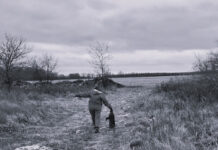When I was a little kid, my mom handed me the saltshaker and told me to go out to the garden and salt all the slugs I could find.
Watching their little bodies liquefy and melt into a puddle left me so traumatized that I couldn’t eat salt for years. Putting salt on a slug indeed ends in its demise, but does such a harsh method have to be employed?
The time for gardening is at hand. If you haven’t started planting yet, I bet you’ve been thinking about it. There are lots of garden pests that try our patience — rabbits, groundhogs, chipmunks — but one of the most frustrating is the slug.
Luckily for me, slugs have never been a problem in my garden, but they can certainly wreak havoc on people’s hard work where they exist in large numbers. The slug’s close terrestrial cousin, the snail, is also present, but doesn’t seem to inflict nearly the amount of damage.

Both slugs and snails are gastropods. This designation is derived from the Greek words “gastro” meaning stomach and “podos” meaning foot. Although locomotion varies slightly between the two, both species maintain travel with the use of a large, fleshy foot, which often leaves behind a slimy trail. Both have two pairs of long tentacles terminating in specialized olfactory organs (simplified eyes) and both feed mainly on plant material. Snails and slugs belong to the mollusk family which also includes oysters, squids, cuttlefish and clams.
Snails are most easily identified by their external shell which they carry around on their backs. This spiral structure offers the snails protection, as they retract inside to escape predators. Snails are found throughout a variety of habitats and environments.
You might have aquatic snails in your aquarium or have noticed large snails in a pond. They can inhabit salt water or fresh water. There are also terrestrial snails which inhabit moist woodlands. You may have even eaten snails in the form of escargot.
During the winter, snails pull themselves deep within their shell and hibernate. Slugs, on the other hand, do not have an external shell like the snail, but they do have an internal shell. This structure is very important as it gives the slug an important source of calcium. Since slugs do not have an external shell, they secrete a layer of mucous to help protect them from predators. During the winter months, they must burrow deep within the soil, where many of them do not survive. This hidden, internal shell is what keeps them from being a menu item like their cousin, the snails.

The locomotion of a snail is painstakingly slow and calculated. Because of their hard shell to which they are permanently attached, they are restricted in their movements. Slugs, on the other hand, are much more maneuverable and can compress themselves to squeeze through tight spaces.
There are many different species of slugs and snails which occur in a variety of colors and sizes, depending upon their ranges. Both are hermaphrodites, containing both male and female reproductive organs with no need for external fertilization. Both species require moist environments and are most active during the cover of darkness.

Ever since my childhood experience with slugs, I have had a soft spot in my heart for them — most likely a result from the guilt I experienced from causing them unfathomable suffering.
When salt is placed on the moist gastropod, it begins to draw the water out of its body through a process called osmosis. This rapid loss of water leads to brutal dehydration, causing its cells to shrivel. Unable to perform bodily functions, the slug dies, virtually appearing to melt. Because it does harbor a simple nervous system, the slug undoubtedly feels pain, and this process of dehydration is obviously excruciating.
Make no mistake, I am not advocating for slugs when they are decimating your garden; yet there are other, more humane ways of eliminating them.
You can pluck them by hand. Collect the slugs after dark when they are most active and place them in a bucket of soapy water. Spread slug pellets — iron phosphate-based pellets contain a naturally occurring mineral that is toxic to slugs and will turn them away. Bait a bowl with beer or other yeasty concoctions to lure slugs in to drown, though be aware that this may end up attracting even more slugs to your garden.
Copper tape creates a mild electric shock when reacting with the slug’s slime, turning them back. Moreover, slugs are nocturnal and avoid light. Scientists have discovered that infrared and red LED wavelengths are very disruptive to their behavior. Installing dim solar lights with a red spectrum will keep slugs away from targeted plants.
Keeping your garden well-weeded and unmulched will eliminate sheltered spots. Lots of open space between your plants will discourage slugs due to the lack of food and hiding places.
Believe it or not, slugs and snails are part of the food web and play an important role in the ecosystem. As decomposers, they feed on fallen leaves and other detritus, turning them back into soil. They are also an incredible food source for so many forms of wildlife including birds, snakes, toads and turtles. By encouraging these predators to visit your garden, such as providing structures that will house toads or water features for the birds, you will have a natural slug control in place.
The challenge is upon us. Choose your tactics wisely!












Thanks for the knowledge re snails & slugs. Every summer a couple slugs travel a stone patio to get to eat the cat food I put in dish on the stoop, I see them on stoop but never see them traveling to or from the stoop. Two questions, what are structures that will house toads & what is lepidoptera? And one comment, surely, you’re trying to be funny suggesting more “humane” ways to deal w/ slugs are, “collect & place them in a bucket of soapy water or bait a bowl with beer to lure slugs in to drown,” seriously?
This article opened my eyes to not only the difference of snails and slugs,but the photos made it easier to allow me to be more mindful
of what I view as garden pests.Instead of being reactive,we can eliminate dark areas and vegetation around raised beds.I use copper mesh in the garden here,and it works.The slugs prefer their beer,though. :)
Tami,once again,your articles enlighten this reader.Many thanks!